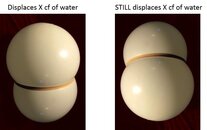The shock cords will not compress the gas in your wing... unless the wing is completely full. If there's room in the wing for the gas to move, it will simply move rather than being compressed.
The likelihood is that you're buoyancy control isn't as good as you think. Your trim certainly isn't if you're "just hanging in the water, fins down" as you say. From a physics standpoint there's no explanation for "extreme positive buoyancy" to magically appear out of nowhere simply from rotating your body from head-up to head-down orientation.
Lots of good advice here, but I have to disagree with this instructor.
If you take a gallon sized steel cylinder and fill it with air, its going to produce 8 lbs of buoyancy at any reasonable depth.
But if you have a cylinder that that can expand depending on whether its up or down, like a cylinder with a flexible bladder in its bottom, the buoyancy will change as the gas pushes up on the bladder. Thats because more water will be displaced.
No doubt bouyancy control is a skill to continually improve, but if you tried this for yourself with the Recon, you would exhaling everything and then pulling on the rear dump when you put your fins up.
I could try to lose 3 lbs of lead...right now my hood fits poorly, catches the exhaust and gas gets trapped in it. Im no expert, but Im sensitive to stuff like that.





